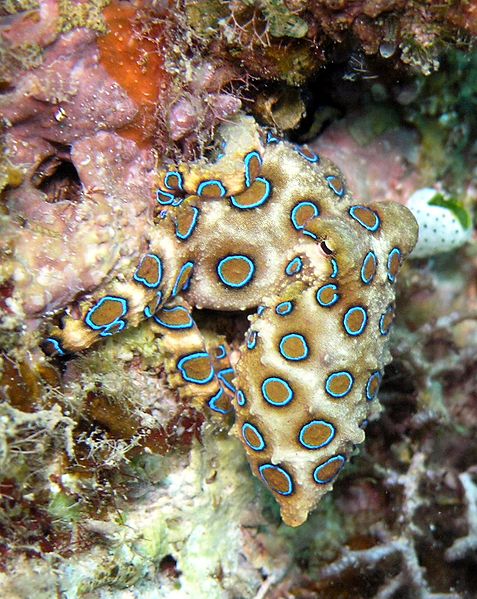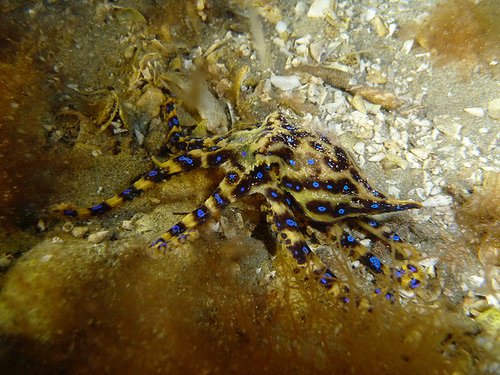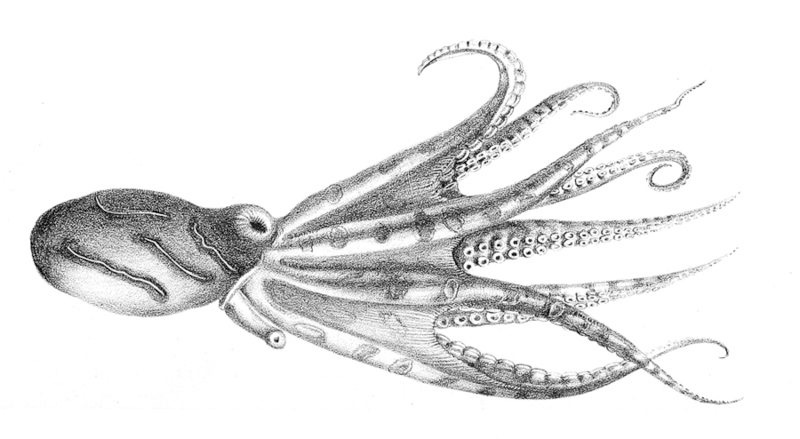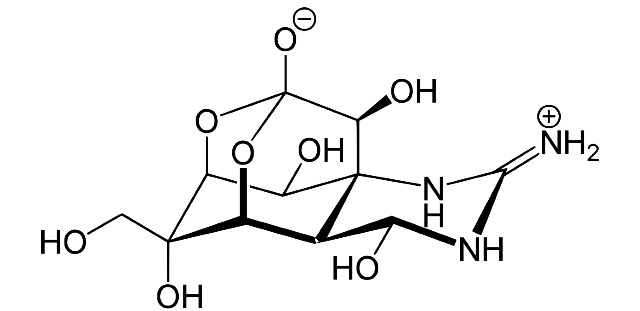THE BLUE-RINGED OCTOPUSES ; ONE OF THE WORLDS MOST VENOMOUS BENTHIC ANIMALS
INTRODUCTION
Hello everyone, it’s been a while but I’m back with an amazing yet dangerous species of aquatic animals. These are the blue-ringed octopuses that make up the genus Hapolochlaena which are very venomous species of octopuses. They can be seen in tide pools and coral reefs in parts of Pacific Ocean in Japan to the parts of Indian Ocean in Australia.
These group of octopuses can be easily identified when you pay attention to their morphological characteristics which include the yellow colour of their skin and the unique blue and black which varies dramatically when disturbed Or threatened. These octopuses have the same taste in searching for food as all of them eat small sea animals which include crabs, shrimp,hermit crap and other crustaceans.
These genus of highly venomous octopuses are divided into four species which include;
- H. fasciata (Hoyle, 1886)
- H. lunulata (Quoy & Gaimard, 1832)
- H. maculosa , (hoyels 1883
- H. nierstraszi ( Adam, 1938)
These octopuses are known to be one of the world’s most venomous aquatic animals. They are small in size with a body length of 5 to 8 inches but dangerous to humans if threatened or disturbed regardless of their relatively gentle nature.
Their venom contains high amount of neurotoxin tetrodotoxin which makes them very dangerous to humans.
The genus of this highly venomous octopuses was described in 1929 by Guy Coburn Robson a British zoologist. It is assumed to have six species under this genus but only four are confirmed for sure. The other two species are still being researched. These species include
- Greater blue-ringed octopus (Hapalochlaena lunulata)
- Southern blue-ringed octopus (Hapalochlaena maculosa)
- Blue-lined octopus (Hapalochlaena fasciata)
And - Hapalochlaena nierstraszi
GREATER BLUE-RINGED OCTOPUS -Hapalochlaena lunulata
Scientific classification Kingdom:Animalia Phylum:Mollusca Class:Cephalopoda Order:Octopoda Family:Octopodidae Genus:Hapalochlaena Robson, 1929 Species: H. lunulata Binomial name Hapalochlaena lunulata (Quoy & Gaimard, 1832)
The greater blue-ringed octopus is small in size like the others in this genus. It has a body length (arm inclusive) of 10 centimeters and weighs about 80grams. It has blue-rings on its body about 7-8 millimeters in diameter which makes it the one with biggest blue rings in this genus, hence its name.
It’s head is a little flattened dorsoventrally and is viewed to be finished in a tip. It possesses short height arms. The color of this octopus changes with a change in its environment or situation from yellow ocher to light brown and to a whitish color when it is not active.
The blue ring is about 60 in number and it is seen all through the body of the octopus. This rings are not perfect ring circles when your take a good look at it. They are not fully circular. This rings are used as an indicator to warn predators that these little guys are indeed very dangerous and they also possess blue lines that runs through their eyes.
They live in distinctive burrows which are easily identified because of the presence of dead legs and bones of crustaceans which is scattered around the entrance of the burrow.
This octopus lives a very lonely life and it is a benthonic animal. The breeding season can be different in different geographical areas. The greater blue-ringed octopus is a carnivorous animal and they keep their eggs incubated by putting under their arms for a period of approximately one month. The females lay approximately 60-100 eggs.
SOUTHERN BLUE-RINGED OCTOPUS- Hapalochlaena maculosa
Scientific classification Kingdom:Animalia Phylum:Mollusca Class:Cephalopoda Order:Octopoda Family:Octopodidae Genus:Hapalochlaena Robson, 1929 Species:H. maculosa Binomial name :Hapalochlaena maculosa (Hoyle, 1883)
This specie is also small in side and a member of the four extremely venomous species of the blue-ringed octopuses.
The approximate size of the mature southern blue-ringed octopus is eight inches that is , when it’s measured from the top of the mantle to the tip of the arms. It weighs 26 grams and is also very gentle just like the greater blue-ringed octopus.
This species is the largest of the genus Hapalohlaena . The blue rings appear and become really visible when it’s been threatened but has a mucus like color when it’s not threatened under normal conditions.
The rings appear on the octopuses body six weeks after it’s been hatched. Another interesting thing about this species of illuminating octopuses is that it contracts and relaxes its muscles for the blue rings. This characteristic is not seen in majority of illuminating animals.
The southern blue-ringed octopuses lives In crevasses and cracks in southern coast of Australia. It enjoys a closeness to the abundant forests of the sea grass in this area.
It has a relatively short life cycle with a significant importance attributed to its reproduction. This short life span that is possesses us approximately six months. This poor thing doesn’t mature early as it reaches its sexual maturity at four months, which puts it under pressure to reproduce at all cost during the remaining two months of its life. Quite sad. Isn’t it?
The method of mating in this species is quite interesting. They are said to be causal and unrestrained in their sexual behavior. Well, who are we to judge? They just got 2 months to make this happen 😂 with their limited gametes.
During its mating period, the females actually are the first to “shoot their shot” by changing color and posture. The male are attracted and mounts on the female in the process inserts its hectocotylus below the mantle of the female and pours sperm into the oviduct the female.
The females collect sperm in this manner from many males (quite polygamous in nature if I would say 😂) and stores it in a place that is stable and becomes more stationary and does not eat until the period of hatching is over. This is one of the reasons why they die almost immediately after hatching their eggs.
Do you know that homosexuality is noticed in this species as octopuses of the same sex have been seen mounting each other, although it is said that the females use a scent to identify males that are most suitable for the course of mating. The females are said to be picky with their choice of mates and the sperm they store.
BLUE-LINED OCTOPUS- Hapalochlaena fasciata)
Scientific classification Kingdom:Animalia Phylum:Mollusca Class:Cephalopoda Order:Octopoda Family:Octopodidae Genus:Hapalochlaena Robson, 1929 Species:H. fasciata Binomial name Hapalochlaena fasciata (Hoyle, 1886)
This octopus is also a member of the four extremely venomous blue-ringed octopuses.It is found in at a depth of 49ft in coastal water and in intertidal rocky shores. It has a mantle that’s about 1.8 inches in length which makes it quite a small species of animals.
Out of all the four of this octopuses in this genus, the blue-lined octopus is the most common. It is mottled yellow brown with dark blue with blue to black streak that covers almost all the parts of the body of the octopuses excluding the underarm when it is not disturbed or threatened.
HAPALOCHLAENA NIERSTRASZI
Scientific classification
Kingdom:Animalia
Phylum:Mollusca
Class:Cephalopoda
Order:Octopoda
Family:Octopodidae
Genus:Hapalochlaena
Species: H.nierstraszi
Binomial name
Hapalochlaena nierstraszi
This is another one of the four extremely venomous octopuses. It has a body length of 82-165mm and weighs about 5.5-18g.
Just like the previous one discussed above they die almost immediately after brooding.
The male changes color and posture abs does something attractive to attract a mate for the purpose of mating. This species mate just like the others by mounting on the female and inserting its hectocotylus inside the mantle cavity of the female which is the area where fertilization occurs.
THE BLUE-RINGED OCTOPUSES AS A WHOLE
BEHAVIOR
Blue-ringed octopuses are known for hiding in crevices while it showcases its beautiful camouflage patterns with the help of their characteristic dermal chromatophore cells.
This octopuses can also change its form or shape just like other basic octopuses and this feature is responsible for how they could become smaller than their original self and squeeze their way in to this cervices where they spend most of their time in hiding.
All of the species in this group change color as soon as they feel threatened. They assume a bright yellow color in the process the 50-60 rings on their body begin to shine prismatic blue in a bid to show aposematic coloration.
They swim by emission of water from a funnel. This octopuses do not have chromatophores above the ring unlike other color changing organisms. They change their colors by contracting or relaxing their muscles.
FEEDING
The blue-ringed octopus uses its venom to halt it’s prey in order to consume it. They feed mainly on crustaceans which include small crabs, shrimps and fish and rare occasions. It has a horny beak and uses it to cut through the tough exoskeleton of the crustaceans and in the process releases its venom. It’s venom paralysis patient and cause them to die.
MATING
As I said earlier mating in this species is very interesting and I’d love to watch them mate live. For most of these species the male uses it hectocotylus (modified arm) to caress the female, it then mounts her in a way that it causes an interference in the females vision then it deposits its sperm in the females oviduct (the mantle cavity).
Mating goes on until the female is satisfied and in some cases the female octopus would have to remove the male by force. Males are so enthusiastic about copulation that they mount on octopuses of the same species regardless of the sex that’s why same-sex mating is noticed in this species.
The females get the chance to lay about 50 eggs as they can only reproduce once in their life time because of their relatively short life span. The eggs are incubated under the females arm and the females do not eat or move too much unless there is need for it. The females die shortly after the eggs mature.
VENOM AND TOXICITY
The venom of the blue-ringed octopuses contains dopamine, tetrodotoxin, histamine, tryptamine, octopamine, taurine and acetylcholine. The venom of this octopuses is so deadly that it can kill a human within minutes if not treated on time.
This venom when injected to the human body can cause heart failure, nausea, respiratory arrest, heart failure, critical and sometimes total paralysis, blindness, and could result in death within minutes if it is not treated immediately. If death eventually occurs it is definitely due to suffocation because of the paralysis of the diaphragm.
You may be wondering why it’s venom is so deadly, well, the main neurotoxin component in the venom is a compound which was formally known as maculotoxin but was later seen to have identical features with tetrodotoxin. Tetrodotoxin is so deadly and is about 1200 times more deadly and toxic than cyanide.
How does tetrodotoxin cause death of the victim ?
It causes motor paralysis by obstructing sodium channels. This also results in respiratory arrest and this toxic substance is produced in the salivary gland of this blue-ringed octopuses.
The venom can only be injected into a victims body if it has a direct contact with the octopus when it feels threatened.
This species of octopus are so dangerous that they can kill about 26 adult humans within minutes regardless of their tiny and most of times painless bite. This is a problem because the victim do not even realize that they are bitten until respiratory arrests begins and paralysis starts to surface. For the records there is no known anti-venom of the blue-ringed octopus’s venom that is available.
TREATMENT
Artificial respiration until proper medical attention arrives is the key to saving the victims life. Apply pressure on the wound and continue the artificial respiration even if the patients seems as tho they are not responding to avoid the development of cyanosis and hypotension.
DO NOT stop this artificial respiration until the person regains the ability to breath on his or her own and also when the paralysis reduces. When patients are taken to the hospital they are placed on a medical ventilator which would help remove the toxins from the victims body.
Patient who tend to recover during the first 24 hours are more likely to recover fully.
CONCLUSION
The blue-ringed octopuses are very beautiful and unique creatures although it’s docile and gentle nature is very dangerous to humans.
It is one of the most extremely dangerous marine creatures because it’s highly venomous and easily threatened. It can kill about 26 humans within minutes if proper medical attention isn’t given to this victims.
They are beautiful, relatively small and boldgentle in nature but shouldn’t be messed with.
REFERENCES
Ref 1
Ref 2
Ref 3
Ref 4
Ref 5
IMAGE SOURCES I am a proud member of the steemSTEM (Science, Technology, Engineering and Mathematics) community. Do you write STEM related articles? Well this is a community for you. Join us on discord here. THANKS FOR READING !
All images used here are from free sources licensed under the Creative Commons and liable for commercial use.



)
Lool...this feels like textual Discovery Channel documentary. Well articulated and informative writeup. Kudos
Thank you 😀
A very informative article btw. You’ve done justice in this post again like you always do in others
Indeed
Thank you.
Although I don't like biology, this post is so well written I can understand.
Thumbs up.
Thank you
You should start liking biology it’s fun and it’s life hahaha
It's life, I agree.
It's fun? 🏃 🏃 🏃
Wonderful inf
Wonderful information
Quite an interesting and exciting read.
The southern blue-ringed octopus are really fascinating. As if their short life span isn't bad enough, they get to spend 2/3 or there life preparing for sexual maturity, and when they're finally sexually mature; they only get to have fun for 1/3 or their life - how sad is that?
An amazing job well done @Florae
That is indeed very sad lol. Hence their homosexuality lol.
Thanks for stopping by
Lol... Lemme just say we humans are just lucky among other animals.
This is the second time i am reading aboit these octopus. They really have something serious going on with them.
I kinda like their color tho. 😁
Who doesn’t ? 😂😂😂😂
Beautiful and very deadly at the same time. Little devils in blue dresses
Thanks for stopping by
Every creature has been equipped by nature with a weapon of defense, regardless of whether they are the calm or wild type. It is essential to their success and survival in their domain.
Well done. You really did justice here.
Yeah true that.
Thank you for stopping by
You are welcome and thanks for sharing too
thanks @florae this is another natgeo wide